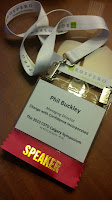 This
week, I have been preparing for back-to-back presentations that are being given
3753 kilometers apart; Calgary in the west and Halifax in
the east.
This
week, I have been preparing for back-to-back presentations that are being given
3753 kilometers apart; Calgary in the west and Halifax in
the east.
After hours of writing I noticed that my design process hasn't changed much since the early 90s when I was a full-time trainer. I wrote
and facilitated many custom-designed sessions in industries as diverse as steel
making, cosmetics, book publishing, non-destructive testing, farming and
retail. It was a fascinating time.
Like many trainers, my biggest challenge is to not create talks
or workshops based solely on my own learning preferences. For example, I am a visual
learner who loves pictures and I prefer to work in small groups solving
problems. But the best presentations appeal equally to all
learning styles.
Here
is how I make presentations that can be seen, heard and felt:
- Write objectives based on needs and session length
- List key learning points
- Arrange points in a logical order
- Add exercises (validate with peers if required. Will it work?)
- Create slides (text only)
- Test design to see if it delivers objectives
- Add visuals for interest and emotional appeal (my favourite step)
- Write the script including stories and examples
- Dry run the slides with the script to test flow, pacing and interest level
- Read the script out loud as I cycle through the slides the night before and morning of the presentation
- Present with no notes, amplifying points through passion, gestures and humour

There are a lot of steps but like all patterns, it has
become a seamless routine. I jot down notes after presenting based on what worked
and what could be improved. There are always things that could have been better seen,
heard or felt.
Phil















